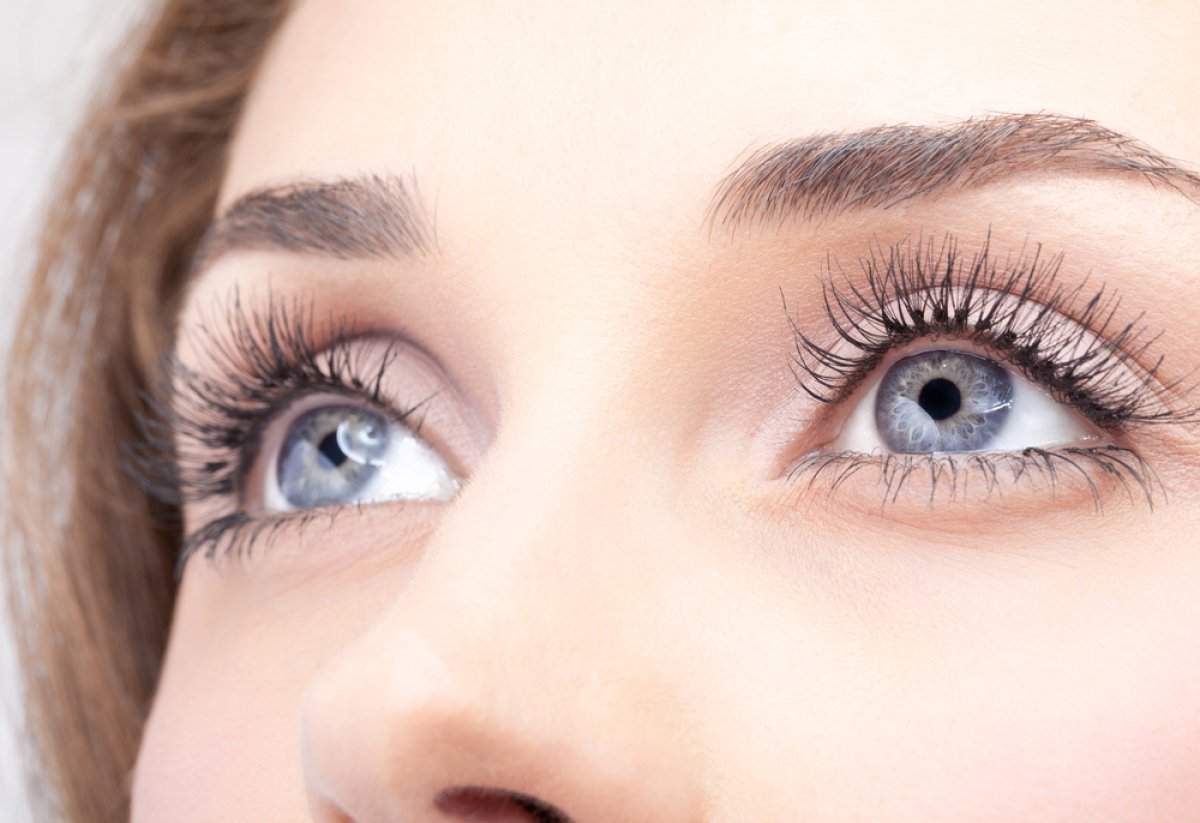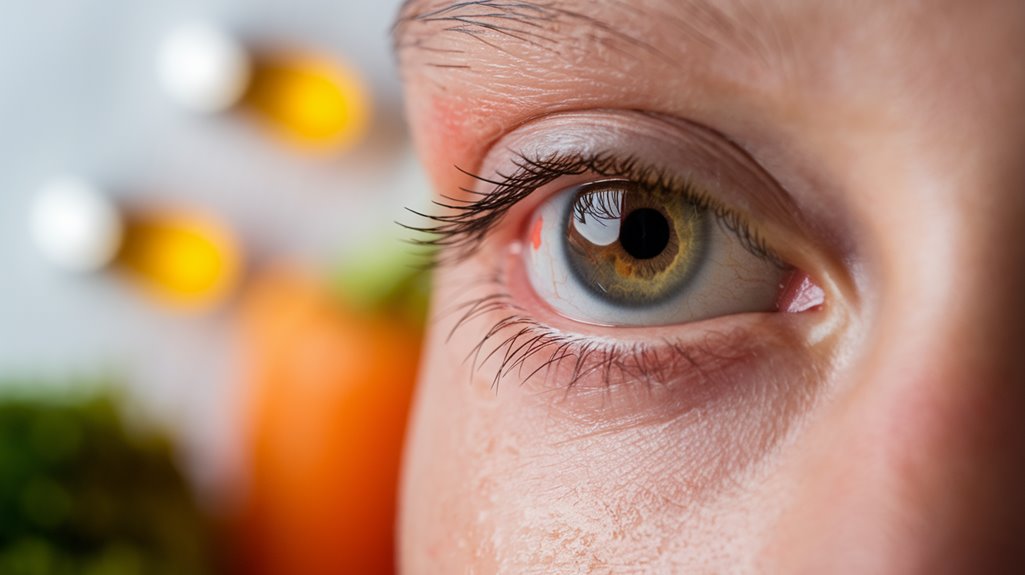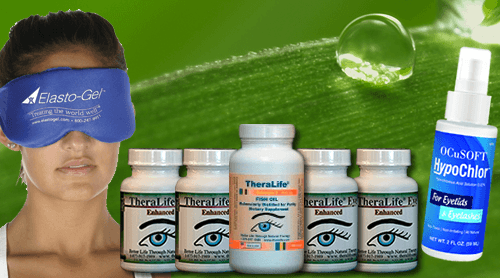TheraLife offers a range of products that can benefit individuals experiencing various eye conditions, including dry eyes. Their focus is on providing natural, holistic solutions to enhance eye health and address specific issues like blepharitis, uveitis, and chalazion. TheraLife’s products are designed to support tear production and reduce inflammation, potentially alleviating symptoms associated with vitamin deficiencies and other underlying causes of dry eyes. By integrating these products into your routine, you may experience improved eye comfort and overall ocular wellness. For those curious about nutrient-rich options to support eye health, TheraLife recommends exploring dietary sources and supplements that align with their holistic approach.
Best Oral Dry Eye Treatment That Works.
Add To CartKey Takeaways
- Vitamin A deficiency can lead to xerophthalmia and reduced tear secretion, causing dry eye symptoms.
- Lack of vitamin D is linked to compromised tear film stability and increased ocular inflammation.
- Vitamin B12 deficiency correlates with severe dry eye symptoms and neuropathic corneal pain.
- Insufficient intake of omega-3 fatty acids may impair meibomian gland function, affecting tear film quality.
- Antioxidant deficiencies, including vitamins C and E, can destabilize tear films and increase oxidative stress.
Vitamin A and Dry Eyes
While you’re exploring ways to maintain ocular health, understanding vitamin A‘s role in preventing dry eyes is crucial.
Vitamin A is essential in protecting the cornea, forming a barrier against bacterial infections, and promoting tear production. A deficiency in vitamin A can lead to xerophthalmia, characterized by corneal dryness and opacity, escalating to severe vision impairment if untreated. The lack of this vitamin compromises tear secretion, resulting in dry eye symptoms like burning and irritation. Ensuring sufficient intake through foods rich in vitamin A, such as carrots, spinach, and liver, is critical for ocular health. In impoverished areas, up to 50% of preschool children suffer from vitamin A deficiency, highlighting the importance of addressing this issue globally.
Clinical evidence suggests that vitamin A supplementation can greatly enhance tear film stability, thereby alleviating dry eye symptoms and safeguarding against related infections.
Vitamin D’s Role in Tear Health
You should consider the critical impact of Vitamin D on tear quality, as its deficiency is linked to compromised tear film stability and increased dry eye symptoms. By integrating Vitamin D-rich foods or supplements into your routine, you can improve tear secretion and reduce ocular inflammation, enhancing overall eye health. Chronic dry eyes can exacerbate inflammation and discomfort, which is why addressing underlying issues like vitamin deficiencies is crucial. Clinical studies consistently demonstrate that adequate Vitamin D levels are essential for maintaining tear integrity and preventing dry eye disease progression. Given that vitamin D deficiency affects an estimated 1 billion individuals globally, it’s vital to be proactive in addressing potential deficiencies to support optimal eye health.
Impact on Tear Quality
Due to its significant role in maintaining tear quality, Vitamin D supplementation is paramount for individuals experiencing dry eye symptoms. It enhances tear film stability, as evidenced by improved Tear Break-Up Time (TBUT) test results. Vitamin D strengthens the corneal epithelial barrier function, essential for robust tear film stability, thereby reducing dry eye symptoms. Its anti-inflammatory properties mitigate ocular surface inflammation, further promoting tear health. By improving the efficacy of lubricating eye drops, Vitamin D optimizes tear quality. Clinical findings, including reduced Corneal Fluorescein Staining Scores (CFSS), demonstrate decreased eye surface damage. Recent studies indicate that Vitamin D supplementation is linked to significant improvements in tear production and stability. Systematic reviews confirm that Vitamin D supplementation not only alleviates dry eye symptoms but also modulates inflammatory responses, ensuring healthier tear production and reduced ocular discomfort. Omega-3 fish oil can also enhance oil film production by meibomian glands, providing another approach to alleviating dry eye symptoms.
Sources and Supplementation
Although vitamin D plays an essential role in maintaining tear health, identifying reliable sources and appropriate supplementation strategies is vital. Dietary sources of vitamin D include fatty fish, fortified dairy products, and egg yolks. However, many individuals may require supplementation to meet ideal levels, especially those with limited sun exposure. Clinical evidence shows that vitamin D supplementation can enhance tear production, improve tear film stability, and reduce ocular inflammation, thereby alleviating dry eye symptoms. Vitamin D deficiency has been linked to an increased corneal dendritic cell density, which correlates with the severity of dry eye disease symptoms. Be cautious about dosage, as exceeding 4,000 IU can lead to toxicity. Psychological associations have also been observed with dry eye conditions, indicating mental health support can be beneficial alongside vitamin D supplementation. While vitamin D supplementation holds promise for dry eye management, it’s important to pursue further research to establish effective dosages and synergistic use with other treatments. Always consult healthcare professionals for personalized advice.
B Vitamins and Eye Lubrication
In addressing dry eyes, Vitamin B12 plays a pivotal role by supporting tear production and repairing the corneal nerve layer, which can alleviate symptoms like burning and irritation. Omega fatty acids, found in foods like fish and oils, also contribute to dry eye relief by forming the stabilizing oil layer in the tear film. Concurrently, Vitamin B6 is essential for maintaining a healthy tear film, thereby preventing the onset of dry eye symptoms. Evidence suggests that ensuring sufficient intake of these B vitamins through diet or supplements is vital for optimizing ocular health and mitigating dry eye disease. Chronic dry eyes often lead to complications such as blepharitis and meibomian gland dysfunction, which can be exacerbated if not addressed.
Vitamin B12’s Role
Vitamin B12 plays an essential role in eye lubrication, particularly in addressing dry eye conditions associated with neuropathic ocular pain. Research reveals that vitamin B12 deficiency correlates with severe dry eye symptoms and neuropathic ocular pain. By enhancing Vitamin B12 absorption, you may alleviate these symptoms. Oral B12 supplements have been shown to nourish and repair the corneal nerve layer, diminishing burning sensations and photophobia. Measuring serum vitamin B12 levels could be vital for patients suffering from severe dry eye and ocular pain, as deficiency is linked to neuropathic complications. Clinical studies support the combination of vitamin B12 supplements with artificial tears, enhancing their efficacy and providing symptomatic relief. These findings underscore the importance of managing B12 levels in dry eye disease. The inclusion of Omega-3 Fish Oil can also contribute to the overall health of the eyes, offering protection against evaporation and supporting tear production. It’s important to note that vitamin D deficiency has also been linked to poor tear quality, highlighting the need to consider multiple nutrient levels in managing dry eye symptoms.
B6 for Tear Film
While maintaining a healthy tear film is essential for eye lubrication, Vitamin B6 plays a pivotal role in this process. This vitamin is vital for tear film stability and overall ocular surface health. Deficiencies can lead to disruptions, causing dry eye symptoms. As an antioxidant, Vitamin B6 protects ocular structures from oxidative damage, supporting the health of your eyes. An autoimmune diet can also contribute to reducing inflammation, which may alleviate symptoms linked to dry eyes. Incorporating adequate levels of vitamin B through diet can also potentially reduce the risk of glaucoma, as suggested by recent studies. Consider incorporating these foods into your diet:
| Food | Vitamin B6 Content | Additional Benefits |
|---|---|---|
| Kale | High | Rich in antioxidants |
| Salmon | High | Omega-3 fatty acids |
| Potatoes | Moderate | High in potassium |
Clinical studies highlight Vitamin B6’s potential to enhance visual function and protect retinal health. Combining it with other B vitamins or antioxidants can further benefit tear secretion and ocular health.
Omega-3 Fatty Acids Impact
Although omega-3 fatty acids have been widely studied for their potential benefits in managing dry eye symptoms, their exact impact remains a topic of debate. You might be aware that these nutrients are thought to support meibomian gland function, enhancing tear film quality by reducing the inflammatory response associated with dry eye disease. Notably, research findings are mixed, with some studies showing no significant improvement in dry eye symptoms over placebo. Despite these omegas’ benefits, the DREAM study found no significant therapeutic advantage, highlighting inconsistencies in clinical outcomes.
The mixed results across various research efforts suggest that while some individuals may experience symptom relief, others do not. This inconsistency may stem from individual variations in disease manifestation or response to supplementation. Additionally, using high-quality omega-3 supplements that undergo molecular distillation can ensure the removal of contaminants, potentially improving the efficacy of the supplements for some users.
Before considering omega-3 supplements, it’s essential to consult a healthcare provider to weigh potential benefits against the high cost and variable efficacy.
Antioxidant Vitamins C and E
After examining the debated role of omega-3 fatty acids in managing dry eye symptoms, it’s beneficial to explore the contributions of antioxidant vitamins like C and E in this regard.
Vitamin C, a potent antioxidant, reduces oxidative stress and eye inflammation, stabilizing tear film and protecting conjunctival tissues from free radical damage. It plays a vital role in alleviating ocular surface inflammation, essential in mitigating dry eye symptoms. A deficiency in vitamin C can exacerbate dry eye symptoms, highlighting the importance of regular consumption of vitamin C-rich foods like oranges and bell peppers. Additionally, the use of TheraLife® Eye capsules can enhance natural tear production, offering a complementary approach to managing dry eye symptoms.
Meanwhile, Vitamin E functions as an atmospheric shield, combating oxidants that cause cellular harm in the eye. It supports healthy tear production and maintains the eye’s surface integrity while preventing inflammation, thereby reducing dry eye symptoms.
Together, these vitamins provide significant antioxidant benefits, essential for maintaining peak ocular health and preventing dry eye syndrome.
Importance of a Balanced Diet
A balanced diet plays an essential role in maintaining ideal eye health by guaranteeing that the eyes receive essential nutrients. Incorporate vitamins A, C, and E, omega-3 fatty acids, and zinc into your dietary habits to support vision and prevent conditions like dry eyes. Nutrition awareness is important as these nutrients help maintain blood vessel integrity, cell protection, and tear production. Antioxidants in leafy greens, carrots, and nuts protect against cellular damage. Foods like salmon and sweet potatoes offer omega-3s and vitamin A, significant for reducing inflammation. Regular eye exams are crucial for the early detection of potential eye health issues, ensuring that any deficiencies are promptly addressed. New diagnostic tools, such as the Matrix Metalloproteinase 9 point-of-care test, enhance clinical evaluation for dry eye syndrome. A diverse diet rich in fruits, vegetables, and lean proteins guarantees thorough nutrient intake. Ultimately, understanding and adjusting your nutrition can prevent deficiencies that adversely affect your eye health.
Lifestyle Factors Affecting Eyes
When examining lifestyle factors that affect eye health, consider the substantial impact of screen time. Prolonged exposure leads to digital eye strain, manifesting as eye fatigue, dry eyes, and blurred vision.
Implementing the 20-20-20 rule can mitigate these symptoms—take a break every 20 minutes to look at something 20 feet away. Incorporate eye exercises to further alleviate strain and enhance ocular flexibility. Adjusting screen brightness and positioning effectively reduces stress on the eyes.
Beyond screen habits, maintaining a balanced diet rich in antioxidants and omega-3 fatty acids supports eye health. Verify regular physical activity to enhance blood flow, delivering essential nutrients and oxygen.
Prioritize sufficient sleep and avoid smoking to prevent exacerbating eye conditions.
Supplements for Eye Health
Understanding the role of supplements in maintaining eye health is essential, especially when dietary intake may fall short.
Lutein benefits your eyes by absorbing harmful blue and ultraviolet light, potentially reducing the need for cataract surgery. Zinc sources, such as supplements, support antioxidant defenses, protecting against cellular damage and facilitating vitamin A’s transport to the retina.
Evidence from the AREDS and AREDS2 studies highlights a 25% reduction in the progression of advanced age-related macular degeneration (AMD) with specific formulations. However, always consult an ophthalmologist before starting supplements, as interactions with medications can occur.
Consider these nutrients for eye health:
- Lutein and Zeaxanthin: Protect against light damage.
- Zinc: Supports antioxidant defenses.
- Omega-3 Fatty Acids: May alleviate dry eye syndrome.
- Vitamin C: Promotes healthy tear production.
Best Oral Dry Eye Treatment That Works.
Add To Cart
Frequently Asked Questions
How Do Hormonal Changes Affect Dry Eye Symptoms?
You’ll notice hormonal fluctuations notably impact eye lubrication.
Estrogen and progesterone levels vary during the menstrual cycle, directly affecting tear production. High estrogen during ovulation can reduce lubrication, while low levels during menstruation worsen dry eye symptoms.
During menopause, decreased estrogen, progesterone, and androgens impair tear and oil production, increasing evaporation and dryness.
Understanding these hormonal impacts helps tailor effective treatments like artificial tears and lifestyle modifications to manage symptoms.
Can Stress Contribute to the Development of Dry Eyes?
Yes, stress can markedly contribute to developing dry eyes.
Stress disrupts tear film balance, leading to reduced tear production and increased evaporation. Chronic stress alters the nervous system, impairing tear film stability and releasing cortisol, worsening symptoms.
Effective stress management is vital for maintaining emotional health. Techniques like deep breathing and meditation can alleviate these symptoms.
Prioritizing emotional health and managing stress can mitigate its impact on your eye health.
Are There Any Medications That May Cause Dry Eyes?
You should be aware that various medication types can cause dry eyes as a side effect.
Antidepressants, including tricyclics and SSRIs, interfere with lacrimal glands, reducing tear production.
Hypertension medications like beta-blockers and diuretics also diminish tear output.
Acne treatments such as isotretinoin impact meibomian glands, affecting ocular lubrication.
Even common pain relievers and decongestants can lead to dry eye symptoms by disrupting tear film stability and aqueous layer production.
How Does Screen Time Impact Eye Moisture Levels?
Imagine the eye as an old-timey camera; screen exposure greatly reduces its moisture levels.
When you’re glued to a screen, your blink rate drops, leading to insufficient lubrication. This moisture reduction accelerates tear evaporation, causing dryness and irritation.
The blue light from screens further exacerbates this, contributing to digital eye strain.
Over time, chronic dryness might damage the corneal surface, underscoring the importance of managing screen time effectively.
What Are the Genetic Factors Influencing Dry Eye Conditions?
When you consider genetic factors influencing dry eye conditions, genetic predisposition and inherited traits play a significant role.
Research shows that genetic variations like the THBS1 gene can reduce tear production, causing dry eyes.
You’re more susceptible if your family history indicates dry eye syndrome.
Ethnic background, age, and gender also interact with genetic factors, affecting your risk.
Understanding these factors helps tailor effective, personalized treatment plans for managing dry eye symptoms.
Best Oral Dry Eye Treatment That Works.
Add To CartConclusion
TheraLife’s products offer a comprehensive solution to support eye health and alleviate conditions like blepharitis, dry eyes, and more. By focusing on a balanced intake of essential nutrients such as vitamin A, D, B, omega-3s, and antioxidants like C and E, these products help maintain optimal tear health. TheraLife provides supplements that work behind the scenes to keep your vision clear and comfortable, addressing lifestyle factors that may contribute to eye discomfort.
TheraLife’s offerings are particularly beneficial for those suffering from chronic eye conditions, providing relief through natural and scientifically-backed methods. Their products cater to a variety of eye-related issues, from managing blepharitis and soothing uveitis to addressing challenges like Sjögren’s syndrome and eyelash mites. With targeted solutions, TheraLife ensures that your eyes receive the nourishment they need, helping you live comfortably regardless of environmental or lifestyle challenges.





